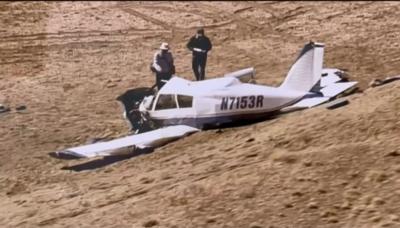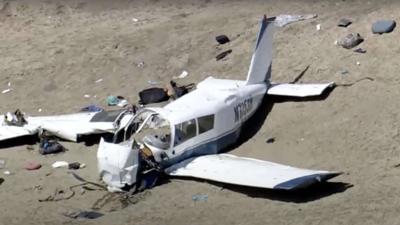Four Perish in PA-28-140 Mishap
The NTSB has released its preliminary report on a 01 October 2023 accident in which a Piper PA-28-140, registration N7153R, was substantially damaged and its pilot and three passengers suffered fatal injuries shortly after departing Moab, Utah’s Canyonlands Regional Airport (CNY). The accident-aircraft was operated as a personal flight under Part 91 of the Federal Aviation Regulations.

The NTSB set forth:
“A security video recorded the airplane landing at 17:47 [MDT] at the Canyonlands Regional Airport (CNY), Moab, Utah. An employee of the Fixed Base Operator (FBO) observed the pilot at the self-serve fuel island, where he purchased 27-gallons of fuel. The pilot then parked the airplane near the fuel island and borrowed a courtesy car from the FBO before driving away from the airport with the other occupants of the airplane.
“Security video captured the four occupants returning and boarding the airplane about 20:11 [MDT]. The video then captured the airplane’s landing light, navigation lights, and anti-collision strobes illuminate and, shortly afterwards, the engine start as evidenced by the propeller spinning. The airplane taxied to runway 21, paused momentarily on the runway, and then departed about 20:23 [MDT]. The pilot-controlled runway lights were not illuminated at the time of the takeoff roll.
“A witness located near the departure end of runway 21 reported that it was very dark outside with no moon illumination. He first heard, then saw the airplane take off to the south. As soon as the airplane lifted off, the “white light in the nose” was turned off. The airplane then turned steeply to the right and stayed in the steep bank until “it was parallel with the runway but going in the opposite direction.” The witness said the airplane appeared to be losing altitude before he lost sight of it and heard two distinct impacts. Automatic Dependent Surveillance-Broadcast (ADS-B) data recovered from the airport’s Virtower equipment was consistent with the witness testimony, showing the airplane climbed to about two-hundred-feet above the ground during the right turn after takeoff, and then descended before the data ended at 20:24 [MDT] near the accident site.

“The airplane was located about 2,540-feet northwest of the departure end of runway 21 on open hilly terrain at an elevation of 4,590-feet above Mean Sea Level (MSL). There were two distinct points of impact. The first point of impact was a gouge near a hilltop. A second point of impact was evident on a bearing of 022° magnetic and about 455-feet from the first impact point. The airplane came to rest upright on a second hill about 65-feet beyond the second impact point. Debris, consisting of the nose wheel, left and right main landing gear, and fragments of the composite landing gear wheel covers was scattered between the first impact point and the main wreckage.
“A post-accident on-site examination of the wreckage revealed flight control continuity from the cockpit to all flight control surfaces. Examination of the engine revealed no mechanical malfunctions or failures that would have precluded normal operations. The airplane was recovered to a secure location.”
The presented information is preliminary in nature and subject to change.
Parties interested in learning more about the described occurrence should reference NTSB Accident Number WPR24FA002.
 ANN's Daily Aero-Linx (05.06.25)
ANN's Daily Aero-Linx (05.06.25) ANN's Daily Aero-Term (05.06.25): Ultrahigh Frequency (UHF)
ANN's Daily Aero-Term (05.06.25): Ultrahigh Frequency (UHF) ANN FAQ: Q&A 101
ANN FAQ: Q&A 101 Classic Aero-TV: Virtual Reality Painting--PPG Leverages Technology for Training
Classic Aero-TV: Virtual Reality Painting--PPG Leverages Technology for Training Airborne 05.02.25: Joby Crewed Milestone, Diamond Club, Canadian Pilot Insurance
Airborne 05.02.25: Joby Crewed Milestone, Diamond Club, Canadian Pilot Insurance




